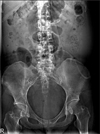Abstract
Purpose
Continuous ambulatory peritoneal dialysis (CAPD) is an important method of performing renal replacement therapy in patients with chronic renal failure. A significant complication of CAPD is malfunction of the catheter because of catheter adhesion that leads to catheter malposition. So we evaluated the effect of an anti-adhesive agent called Guardix-Sol®.
Methods
We prospectively evaluated the clinical results of 78 patients who had received CAPD catheter insertion from Sep. 2007 to May 2009. A test group of 34 patients used the anti-adhesion agent and a control group of 44 patients did not use it. All the procedures were standardized and performed by a single surgeon.
Results
The patients consisted of 49 males and 29 females. The common reasons for CAPD insertion were diabetic nephropathy (47 patients) and hypertension (20 patients). Fifteen patients needed reposition operations during their postoperative course, which were done under spinal anesthesia. Out of 15 patients, 3 were from the test group (Guardix-Sol® group) and 12 from the control group (P=0.0526). All the repositioned patients had a malpositioned catheter because the greater omentum had adhered to the catheter, except for one patient in each group (P=0.0315).
Figures and Tables
Fig. 2
(A) The continuous ambulatory peritoneal dialysis catheter tip is located in the Douglas pouch. (B) The fluoroscopic view shows a properly placed continuous ambulatory peritoneal dialysis catheter in pelvic cavity.

References
1. Popovich RP, Moncrief JW, Decherd JE, Bomar JB, Pyle WK. The definition of a novel portable-wearable equilibrium peritoneal dialysis [abstract]. Trans Am Soc Artif Intern Organs. 1976. 5:64.
2. Lee HB. Continuous ambulatory peritoneal dialysis. Korean J Med. 1981. 24:942.
3. Levey AS, Harrington JT. Continuous peritoneal dialysis for chronic renal failure. Medicine (Baltimore). 1982. 61:330–339.
4. Moncrief JW, Popovich RP. Continuous ambulatory peritoneal dialysis best treatment for end-stage renal disease. Kidney Int Suppl. 1985. 17:S23–S25.
5. De Paepe MB, Schelstraete KH, Ringoir SM, Lameire NH. Influence of continuous ambulatory peritoneal dialysis on the anemia of endstage renal disease. Kidney Int. 1983. 23:744–748.
6. Oreopoulos DG, Khanna R, Williams P, Vas SI. Continuous ambulatory peritoneal dialysis - 1981. Nephron. 1982. 30:293–303.
7. Moreiras Plaza M, Cuina L, Goyanes GR, Sobrado JA, Gonzalez L. Mechanical complications in chronic peritoneal dialysis. Clin Nephrol. 1999. 52:124–130.
8. Cogan MG, Schoenfeld P. Introduction to Dialysis. 1991. 2nd ed. New York: Churchill Livingstone.
9. Schoenfeld P. Cogan MG, Garovoy MR, editors. Care of the patient on peritoneal dialysis. Introduction to Dialysis. 1985. 1st ed. New York: Churchill Livingstone;145–195.
10. Cruz C. Implantation techniques for peritoneal dialysis catheters. Perit Dial Int. 1996. 16:Suppl 1. S319–S321.
11. Georgiades CS, Geschwind JF. Percutaneous peritoneal dialysis catheter placement for the management of end-stage renal disease: technique and comparison with the surgical approach. Tech Vasc Interv Radiol. 2002. 5:103–107.
12. Brownlee J, Elkhairi S. Laparoscopic assisted placement of peritoneal dialysis catheter: a preliminary experience. Clin Nephrol. 1997. 47:122–124.
13. Allon M, Soucie JM, Macon EJ. Complications with permanent peritoneal dialysis catheters: experience with 154 percutaneously placed catheters. Nephron. 1988. 48:8–11.
14. O'Regan S, Garel L, Patriquin H, Yazbeck S. Outflow obstruction: whiplash technique for catheter mobilization. Perit Dial Int. 1988. 8:265–268.
15. Bierman MH, Kasperbauer J, Kusek A, Hammeke MD, Fitzgibbons RJ Jr, Egan JD. Peritoneal catheter survival and complications in end stage renal disease. Perit Dial Int. 1985. 5:229–233.
16. Joung YH, Lee TW, Kim HJ, Ihm CG, Kim MJ. Comparison of the rate of catheter malposition and survival according to the site of catheter tip placement. Korean J Nephrol. 2001. 20:447–451.
17. Lee YG, Chu B, Kim NH, Kim JH, Lee YW, Kim KI, et al. The efficacy and safety of HA/CMC anti-adhesion barrier solution with varying viscosities. J Korean Surg Soc. 2008. 74:399–404.
18. Ray NF, Larsen JW Jr, Stillman RJ, Jacobs RJ. Economic impact of hospitalizations for lower abdominal adhesiolysis in the United States in 1988. Surg Gynecol Obstet. 1993. 176:271–276.
19. Van Der Krabben AA, Dijkstra FR, Nieuwenhuijzen M, Reijnen MM, Schaapveld M, Van Goor H. Morbidity and mortality of inadvertent enterotomy during adhesiotomy. Br J Surg. 2000. 87:467–471.




 PDF
PDF ePub
ePub Citation
Citation Print
Print






 XML Download
XML Download